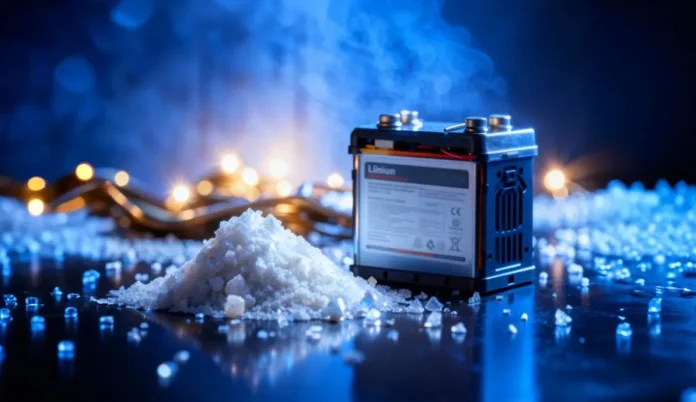In the race toward a green future, a hidden danger is quietly poisoning the planet. Lithium-ion batteries, the lifeblood of everything from electric vehicles to home inverters, are now under scrutiny for containing “forever chemicals,” toxic compounds that never break down in nature. As industries tout these batteries as the cornerstone of sustainable living, a growing body of evidence suggests they may be leaving behind an irreversible environmental scar.
Recent reports have revealed that per- and polyfluoroalkyl substances (PFAS), commonly referred to as “forever chemicals,” are used in the production of lithium-ion batteries. These synthetic compounds, designed for durability, are resistant to heat, water, and oil — the same properties that make them useful in manufacturing but devastating when released into the environment. Once discharged, PFAS persist for centuries, seeping into soil, rivers, and human bloodstreams.
For years, lithium-ion batteries have been hailed as the silent champions of clean energy. They power the electric vehicles meant to replace gas-guzzlers and store solar energy in households striving for carbon neutrality. Yet, beneath the glossy promise of sustainability, scientists are now warning that the battery industry’s reliance on PFAS paints a grim picture.
According to environmental researchers, PFAS are being used in battery separators and electrolytes to enhance performance and stability. However, when these batteries are manufactured, damaged, or improperly disposed of, PFAS can leak into the environment, contaminating air, water, and soil.
“People think they’re buying into a cleaner future when they install a lithium-ion inverter or drive an electric car,” says environmental chemist Dr Lillian Hart, “but what they don’t realise is that these same technologies could be sowing long-term toxic damage.”
The dangers don’t stop at chemical pollution. Faulty lithium-ion batteries have already earned notoriety for their tendency to overheat and catch fire, from smartphones to electric scooters to home energy systems. When these batteries ignite, they release a cocktail of harmful gases, including hydrofluoric acid and other fluorinated compounds, further intensifying the environmental toll.
“Every battery fire is a chemical disaster in miniature,” says Dr Hart. “When a lithium battery burns, PFAS and other toxins are released into the atmosphere. What’s billed as a clean technology can quickly turn into a public health threat.”
In homes across the country, inverter batteries have become a common sight, installed to store energy from rooftop solar panels. But these same systems, often marketed as eco-friendly and maintenance-free, may be ticking time bombs. Poor manufacturing standards, subpar cell quality, and inadequate disposal regulations are leading to hazardous failures and chemical leaks.
Governments and corporations have invested billions in electrification initiatives, but few have fully addressed the environmental costs. Battery manufacturing hubs in China, South Korea, and the U.S. are producing millions of cells each year, each one containing microscopic traces of PFAS. Once production waste is improperly dumped or recycled, these forever chemicals enter waterways and accumulate in wildlife.
Studies from the European Chemicals Agency (ECHA) show that PFAS contamination is now detectable in almost every major river system worldwide. In the U.S., the Environmental Protection Agency (EPA) has identified PFAS as a critical contaminant, linking it to cancer, immune dysfunction, and reproductive harm. Yet, regulations around their use in lithium-ion batteries remain vague and under-enforced.
“The irony is staggering,” says consumer advocate Maya Fernandez. “We’re poisoning the planet in the name of saving it. Until we hold manufacturers accountable and demand transparency, consumers will continue to contribute to this toxic cycle unknowingly.”
The Recycling Mirage
Another growing concern is what happens to a battery at the end of its life. Recycling is often presented as a cure-all for the battery waste crisis, but experts warn that current recycling processes are ill-equipped to handle PFAS contamination.
At many recycling facilities, damaged lithium-ion batteries are shredded to recover valuable metals, such as nickel and cobalt. But this process can release toxic PFAS-laden dust, endangering workers and polluting nearby communities. In some cases, fires have erupted during recycling, spreading contaminated smoke and ash over wide areas.
Despite these hazards, the global appetite for lithium-ion batteries shows no sign of slowing. With electric vehicle adoption skyrocketing and home energy storage becoming mainstream, the world could see battery waste multiply fivefold by 2030. Unless industry practices change, the scale of the pollution problem will also change.
For consumers, awareness is the first line of defence. Experts advise checking for safety certifications when purchasing lithium-ion inverters, avoiding unbranded imports, and ensuring proper ventilation around battery installations to minimise the risk of fire. More importantly, used or damaged batteries should never be discarded in household trash — they must be taken to certified recycling centres equipped to handle hazardous materials.
Activists are also urging governments to implement stricter regulations on battery production, including mandatory disclosure of PFAS use and the adoption of safer alternatives for manufacturing. Without decisive action, the supposed green revolution risks becoming a toxic legacy for future generations.
A Warning Ignored
The discovery of forever chemicals in lithium-ion batteries is a sobering reminder that sustainability cannot come at any cost. True environmental responsibility demands transparency, safety, and a willingness to confront uncomfortable truths, even about technologies we once believed were saving us.
For now, consumers are caught between two realities: one powered by progress, and another poisoned by its byproducts.
The question remains, how much of the planet’s health are we willing to sacrifice in the name of clean energy?
Read the Latest Battery News Shaping the Global Power Market


